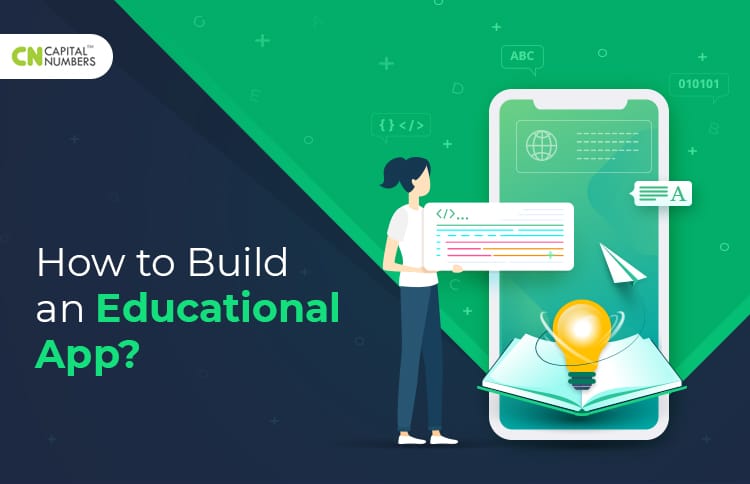How to Build an Educational App?
Table of Contents
To date, compulsory school and campus closures due to the COVID-19 outbreak have barred millions of students from attending school in person.
Happily, the shutdowns have led to the massive growth of educational apps and online learning. Today, students swear by the educational apps after experiencing the benefits first-hand. These apps help students learn independently at their own pace, brush up on key content, and re-read, as per their choice. Reports suggest that the educational app downloads worldwide grew 90% in 2020 compared to the fourth quarter in 2019.
Several companies plan to develop custom online learning apps and bolster student productivity to tap into this growing educational apps market.
If you’re one of them, here’s how you can build such an app to improve education outreach in this post-COVID world:
How to Build an Educational App?
| Easy Signup
Simplify the signup process for students and teachers by adding no more than three input fields in the app registration form to maximize user participation and app downloads. |
A Clean Dashboard
Create a well-designed app dashboard to help users get a unified view of critical metrics such as class time tables, exams, attendance, holidays, fee descriptions, circulars, teacher’s list, etc., on a single page. |
| Interactive Content
Use instructional videos, quizzes, poll questions, animations, images, and stunning presentations to keep students engaged, focussed, and motivated during the entire learning process. |
Powerful Database
Make sure you add an architecturally robust and scalable database to store and update user profiles, study materials, videos, question papers, revision notes, etc., regularly. |
| Live Tutorials
Host live tutorials so that students engage in real-time conversations with the teachers and clarify doubts instead of relying on pre-set questionnaires. |
Mock Tests
Upload mock test papers to enable students to understand exam patterns, improve answering strategies, manage time, identify assessment criteria, and evaluate themselves before appearing for the final exam. |
| Offline Mode
Provide offline content access so that students and teachers can save tutorials, videos, and PDFs, directly to their mobile devices, access them even when there’s no Internet connection, and stay away from buffer wheels. |
Push Notifications
Add push alerts to notify users about courses completed, upcoming classroom events, virtual rewards, attendance reports, and other essential updates in real-time. |
| Gamification
Gamify learning sessions, add fun-filled activities and let students earn points so that each one feels rewarded for his efforts and gets to stimulate his creativity. |
Progress Tracking and Achievements
Add a progress tracking mechanism so that teachers can track students’ achievements, progress, results, areas of difficulty, etc., and improve instructional methods accordingly. |
| Search Functionality
Improve content discoverability and user journey by adding a powerful search functionality that lets users quickly find test papers, projects, lectures, training sessions, events, etc., as per their preferences. |
Payments
Integrate a reliable online payment gateway so that each learner can securely pay his fees to attend virtual classes, access live streams, take up advanced-level courses, and more, without worrying about fraudulent transactions. |
The above will not only help you create a robust educational app but also enable you to create efficiencies, reduce costs, and democratize education.
Potential Benefits of Educational Apps
Experts cite that factors like universal availability, affordability, flexibility, modernity, and personalized learning have further led to the massive adoption of educational apps.
Besides, these apps provide frequent parent-teacher interactions, which fosters transparency regarding children’s growth at schools. Also, unlike traditional learning methods, app-based learning encourages students to learn anywhere and at any time, thereby providing immense portability.
These potential benefits have caused a surge in educational app downloads this year, with 470 million educational app downloads through Apple App Store and 466 million downloads through Google Play. (Source: Statista)
The Booming Educational Apps Market
Post lockdown, the educational apps market has attracted huge investments from all quarters. Moreover, a recent Statista report indicates that the expenditure on advanced EdTech (educational technology) worldwide will reach US$12.6 billion by 2025.
Around 92% of teachers have even expressed that they would like to use EdTech (educational technology) a lot more. (Source: The Harris Poll)
These optimistic forecasts have further led companies to invest heavily in educational apps and change classroom environments forever.
If you’re thinking of leveraging educational apps’ power and carving a niche in EdTech, reach out to us.
How Can Capital Numbers Help?
Capital Numbers has delivered dozens of projects to Fortune 500 companies, educational institutions, startups, and non-profits globally and earned hundreds of happy clients.
With over a decade-long experience, we can craft bespoke learning app solutions to help you stand apart from the rest of the pack.
We can step in and help you at any stage of your educational app development project.
Just drop us a line, and we’ll get back to discuss your project needs in no time.














